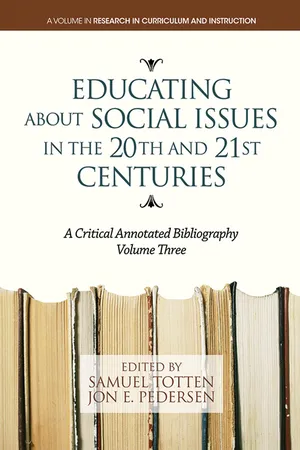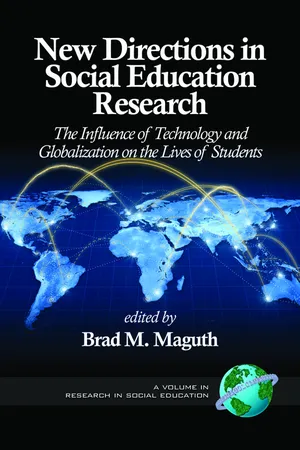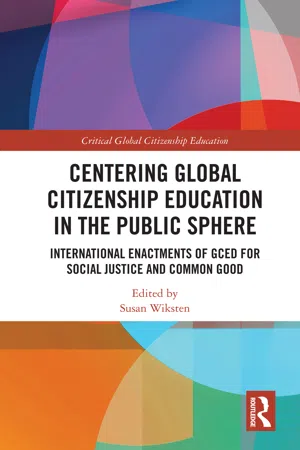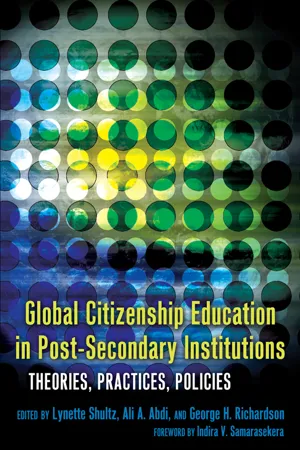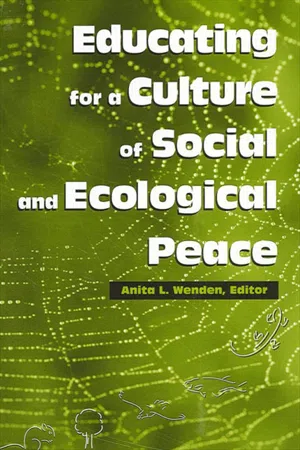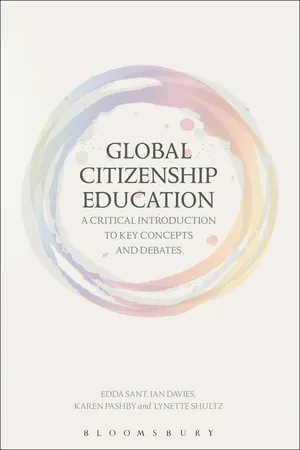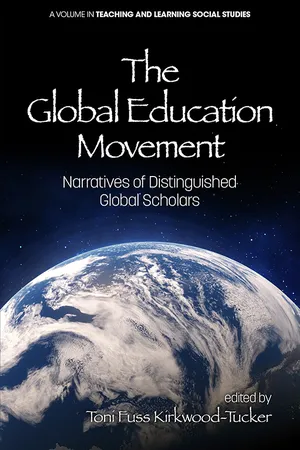Social Sciences
Global Education
Global education refers to a comprehensive approach to learning that emphasizes understanding and addressing global issues, promoting intercultural understanding, and fostering a sense of global citizenship. It aims to develop students' knowledge of global interconnectedness, cultural diversity, and social justice, preparing them to engage with and contribute to the global community.
Written by Perlego with AI-assistance
Related key terms
1 of 5
12 Key excerpts on "Global Education"
- Samuel Totten, Jon Pedersen(Authors)
- 2013(Publication Date)
- Information Age Publishing(Publisher)
While different scholars or conceptual frames in the field emphasize different aspects of global interdependence, they share the belief that education with a global perspective is more than adding on new courses in the realms of world geography and history. Rather, it requires a holistic approach to transform curriculum and pedagogy to provide students with an understanding of themselves and their relationship to the world com- munity. Global Education, when soundly developed and taught, teaches students to examine the world as a whole through knowledge of human values and global systems (economic, political, environmental, technolog- ical) via a range of global issues such as conflict, security, human rights, economic development, and environmental challenges and stewardship, global history, cross-cultural understanding, and awareness of human choices A greater emphasis is placed on the need to help students develop Trends and Issues in Global Education 353 an outlook to see the world as a “sociopolitical, planetary biosphere” (Gutek, 1993, p. 19) and to develop an ability to build bridges across cul- tural boundaries in order to be able to communicate and collaborate with those whose attitudes, values, knowledge, and ways of doing things differ significantly from their own. Scholars further argue that global educa- tion should become an essential aspect of the school curriculum to better prepare all students to make informed decisions for a more peaceful, just and sustainable world. To provide a context for Global Education and its relationship to teach- ing and learning about social issues, we begin with a brief overview of historical development of Global Education and major theoretical frame- works for interpreting the field. In doing so, we examine the field’s core principles and key beliefs that distinguish Global Education from tradi- tional approaches to world studies (culture, geography, history).- eBook - PDF
- Brad M. Maguth(Author)
- 2008(Publication Date)
- Information Age Publishing(Publisher)
Before discussing the connection between Global Education and social change, it is informative to briefly review the definitions of and connec- tion between the two concepts. Global Education involves the development of capacities that support individuals in “evolving multiple forms of citi- zenship, exercised at different levels and across the different dimensions of their lives (ecological, political, social, and cultural)” (Lapayese, 2003, p. 494). Her view, based on a literature review of relevant works by Osler and Vincent (2002), Scott and Lawson (2002), and Schwiesfurth, Davies, and Harber (2002), identifies Global Education as a form of civic engage- ment on a global scale. The notion of civic engagement, as defined by the American Psychological Association, reflects the totality of “individual or collective actions designed to identify and address issues of public concern” (Delli Carpini, 2012). Within the global framework advanced by Lapayese (2003), the capacities associated with civic engagement, taken in conjunc- tion with global perspectives, means that globally educated individuals would be able to effectively identify and take action individually or collec- tively on issues of global concern. The key concepts in this Global Education include dimensions like sustainable development, social justice, diversity, conflict resolution, and human rights (p. 495). The social changes associated with a civically engaged citizenry at the national level typically involve behaviors associated with knowledge of and participation in formal or informal political processes. - Samuel Totten, Jon Pedersen(Authors)
- 2013(Publication Date)
- Information Age Publishing(Publisher)
So, what does it mean to be global? For some, Global Education is situated around notions of be- ing academically competitive in relation to other countries across the globe or that students in the United States should be equal to or better than their international peers, thus flexing and reaffirming American power (Burack, 2003; Clough, 2008; Smith, 2006). Other scholars have taken a humanis- tic/personal view, promoting cross-cultural communication, learning and understanding through dialogic engagement (Merryfield, 2002; Merryfield & Kesai, 2004). A recent turn in the Global Education literature, if not in its practice, is towards global citizenship (Gaudelli, 2003, 2009; Gaudelli & Heilman, 2009; Myers, 2006, 2008; Osler & Vincent, 2002). And still other scholars believe that Global Education should be centered around a foun- dation of economic social justice (Bigelow & Peterson, 2002; McLaren & Farahmandpur, 2005). Schools in the U.S. have generally fallen short of educating students globally. This is due to numerous reasons. First, the nation-bound curricu- lum, particularly as it relates to the field of history, hold sway in many sec- ondary schools. Second, global issues are viewed by some as too complex and daunting for secondary students, such that the safety of the known is preferred over the uncertainty of the unknown. Third, now in their second decade of enactment, federal and state policy initiatives that generally aim to standardize curriculum and assess student knowledge in core curricu- lum largely exclude social studies. Within this educational context, innova- tions have generally been focused on school-wide reforms in heavily tested areas, such as English and mathematics, rather than curriculum changes in social studies. A possible exception to the relative absence of Global Education in U.S. schools is the rise of the world history curriculum after 1980.- eBook - ePub
Centering Global Citizenship Education in the Public Sphere
International Enactments of GCED for Social Justice and Common Good
- Susan Wiksten(Author)
- 2021(Publication Date)
- Taylor & Francis(Publisher)
IntroductionCritical Global Citizenship Education as a Form of Global Learning
Susan WikstenPublic Spheres and Education
Education is a practice that is guided by multiple perspectives and theories. Since the twentieth century, a broad support has been accorded by many education experts to constructivist approaches that have been supported with evidence from cognitive research in psychology (Piaget & Weil, 1951). However, education has never achieved a singular paradigm across the globe; a multitude of theories and traditions guides the work of education professionals today. The fragmented nature of the field of education is necessary as theories of education form within different societies, education serves a variety of purposes, and the societal circumstances are different across the globe. Critical scholars and educators have already for decades alerted us to some of the unsuccessful features of efforts to modernize education; such as different forms of violence in the context of education, the abnegation of minority groups in practices of education, or the reinforcement of asymmetrical power relations based on social positionality (Bourdieu & Passeron, 1970; Freire, 1970; Bernstein, 1977; Morrow & Torres, 1995; Stromquist, 2015; Howard & Navarro, 2016).A renewed call for ethically grounded leadership in education calls the attention of both practitioners and scholars in global citizenship education (GCED) to questions of social justice in education (cf. Zeichner, 2009; Westheimer, 2015; Howard & Navarro, 2016). Social justice in education is about promoting what we understand as fair practices in education. What is fair in a society is associated with the extent to which the interests of different groups in society are represented in education (Crenshaw, 1989; Schement, 2001). A basic political mechanism for promoting representation is the use of deliberative practices. Deliberation, however, does not take place automatically in societies, nor in the context of education, but requires the availability of designated practices, resources, and spaces. In a classic work of political theory, Habermas identified coffee houses in eighteenth- and nineteenth-century London as spheres between civil society and State. Places where critical public discussions were possible. The coffee houses in London were important for a particular kind of governance shift. These public spheres contributed to a situation where, instead of a ruler monitoring the compliance of the people, the people formed a practice of informed and critical discourses for monitoring the actions of State authority (McCarthy in Habermas, 1989, p. xi). The purpose of this book is to explore the ways in which the Global Citizenship Education agenda of the United Nations (UNESCO, 2014, 2015; Tawil, 2013) can contribute to fostering new public spheres or alternatively to revitalize existing public spheres (Habermas, 1979), and also, to encourage rethinking of what we mean by ‘public sphere’ in the context of education (cf. Fraser, 1990), considering for example online discourses as a new public sphere site. - eBook - PDF
- Zlatan Delic(Author)
- 2012(Publication Date)
- IntechOpen(Publisher)
The challenge here is to integrate contextual and more general perspectives in a mirror game which can help us to have an effective portrait of the complex reality we are asked to deal with. To the development of a “global needs conscience” and of a “global citizenship” it is necessary to connect a wide awareness of the opportunities available in the different social systems within a global scenario, in order to sustain greater aspirations and release greater energies. Within this framework, “global citizenship” can be considered as a result of both “Global Education” and the “globalization of education”. Indeed, the call for a “Global Education” is a problematic issue from a pedagogical point of view. Global Education is not only a process aimed at providing all global citizens with abilities, knowledge, skills and understanding in order to create a well informed, trained, and motivated workforce (which may have an effective inclusion in a globalized job market Globalization and Responsibility 58 within a globalized economy), but a more complex and articulated process of cultural and social change and development, based on a new vision and a new understanding of global problems. This perspective is enlightened in the Maastricht Global Education Declaration, which emphasizes that Global Education is “essential for strengthening public support for spending on development co-operation. All citizens need knowledge and skills to understand, participate in and interact critically with our global society as empowered global citizens” (EU, 2002). From this perspective Global Education is principally envisaged as a process of empowerment for individuals and groups as far as we consider empowerment to be a multi-dimensional, complex process (Cuzba, Page, 1999), which leads to individual and collective growth, grounded on the possibility of a full acknowledgment and use of inner resources. - eBook - ePub
- Lori Diane Hill, Felice J. Levine, Lori Diane Hill, Felice J. Levine(Authors)
- 2018(Publication Date)
- Routledge(Publisher)
Though Global Education is not a new concept (Hill, 2012; Tye, 2009), there has been a growing body of research focused on cosmopolitanism, internationalization, global citizenship and global competency in education (see Frey and Whitehead, 2009; Gardner, 2004; Noddings, 2005; Suarez-Orozco and Qin-Hillard, 2004). While frequently invoked, these concepts do not have single, agreed-upon definitions. Moreover, the literature uncovers a variety of rationales (economic, political, sociocultural, academic) that complicate our understanding of what drives Global Education policy and practice (de Wit, 1999, 2002; Knight, 2004, 2006). In some articulations, Global Education is important for generating revenue through the Global Educational marketplace or for fostering skills to serve economic or national security purposes. For example, in an economic orientation, the emphasis may be on language learning or intercultural communication as core competencies, where the overarching goal is competitiveness—both among individuals and countries. Alternatively, Global Education also stresses associated sociocultural values—including understanding, mutual respect and empathy—that underscore collaboration rather than competition.These different rationales are illustrated by leading international organizations (i.e., OECD, UNESCO) as well as in the literature, revealing an endemic tension whereby, on the one hand, Global Education is framed as a means to advance national economic competitiveness and national security in response to key risks facing the nation, thus reinforcing more isolationist tendencies. On the other hand, Global Education approaches include normative concepts—such as teaching the value of diversity—and aim to be action-oriented as part of a ‘commitment to equity and social injustice’ (Oxfam, 2015: 3), an orientation to citizenry that extends beyond national borders. The literature has highlighted these as tensions or dialectics of ‘solidarity/competitiveness’ (Torres, 2015) that underlie and drive multiple motivations of Global Education. For example, using the European context as a backdrop, Van der Wende (2001) noted the increasing emphasis on economic rationales, highlighting the tensions emerging between competition and cooperation. He articulated two seemingly conflicting paradigms for internationalization policies, whereby neighboring European countries tend to take a cooperative approach, while in Anglo-Saxon countries Global Education policies are more often linked to gaining or maintaining a competitive advantage in the global market. The multiplicity of rationales—and the fact that these are sometimes in tension—underscores the challenge of understanding international and comparative approaches to Global Education, both in strategic documents, where these rationales are embedded in policy discourse, and in the interpretations of individual stakeholders. - eBook - PDF
Global Citizenship Education in Post-Secondary Institutions
Theories, Practices, Policies- Foreword by Indira V. Samarasekera
- Ali A. Abdi, George H. Richardson, Lynette Shultz(Authors)
- 2011(Publication Date)
At its best, global citizen- ship education speaks to how humanity might organize itself to address the very criti- cal issues of this time and how this can happen through just political, economic, and social relations with a consideration of the global/globalized context for such educa- tion. Current research in global citizenship education describes the problems of domination by the economic project of a neoliberal global market (see, for example, Harvey, 2005; Stewart-Harawira, 2005); global governance structures and processes that describe citizens’ relationship to nation states in a globalized context (see, for ex- ample, Erman, 2005; Dryzek, 2000; Held, 1995 ); the growth and emergence of social movements to address issues that extend beyond nation states such as environmental destruction, climate change, or health issues (see, for example, Dryzek & Schlosberg, 2005; Soskolne et al., 2008); the need for understanding global social justice that in- cludes cognitive justice (de Sousa Santos, 2007; Odora Hoppers, 2009, 2000) and the inclusion of multiple epistemologies within education (Weber-Pillwax, Kelly, Shultz, & Lange, 2009; Abdi, 2009; Odora-Hoppers, 2000, 2009). While this rich diversity of Shultz 14 locations and discourses might suggest that the term “global citizenship” has become emptied of its meaning, it should also be understood to be an indication of an authen- tic and extensive engagement within the public sphere that results in multiple theo- retical and practical extensions. It is in such a rich and contested public sphere where global citizenship education holds its greatest possibility as a generative project of so- cial justice; a public sphere where there is deliberation, engagement in conflict, and a space where citizenship claims and exchanges are moved outside the exclusive enclaves of the elite (see Abdi & Shultz, 2008a; Shultz, 2009). - eBook - ePub
The State of Global Education
Learning with the World and its People
- Brad Maguth, Jeremy Hilburn(Authors)
- 2015(Publication Date)
- Routledge(Publisher)
Conceptual vagueness and terminological ambiguity of global citizenship, propensity to develop and teach national citizenship, and lack of curricular security and administrative support are major obstacles that GCE faces in schools. When we say “global citizenship education,” what we usually mean is creating an atmosphere in the classroom or school conducive to raising questions about global issues; discussing local, regional, or national problems by placing them in a global context; being able to ask difficult questions that do not always have definite answers; and not being afraid to discuss controversial issues. In a word, the teacher becomes the most important link in the educational chain that connects our young generation with the growing societal understanding of the inevitability of global changes. Society, business, and even the legislature, although to a lesser extent, are ready for a paradigmatic shift that will eventually result in embracing global citizenship on the same level as we now experience national or local citizenships. Are education practitioners, both classroom teachers and school administrators, prepared to translate the societal need for a new, more globally oriented citizenship paradigm into meaningful changes in curricula and instruction in classroom discourse? Do teacher education programs or professional development programs equip practitioners with the necessary tools that will facilitate the education of globally minded citizens? To answer this question, we first have to identify content and tools that will define and direct global citizenship education discourse.Moving Forward
There is a consensus among theorists that the defining topics in global citizenship education narrative are those that problematize such areas as universal ethics, universal human rights, social justice, globalization, mono- vs. multicultural dichotomy, and all types of inequalities (Banks, 2004 , 2008; Carter, 2001 ; Dower, 2003; Gaudelli & Fernekes, 2004 ; Heater, 2004 ; Osler & Starkey, 2010 ; Oxfam, 2006; Suárez-Orozco & Qin-Hilliard, 2004 ). As for techniques and strategies in GCE, there is a growing body of literature, mostly exploratory empirical studies, that analyzes both best practices and general experiences of teachers and administrators in all aspects of Global Education (Davies et al., 2005 ; Evans et al., 2009 ; Leduc, 2013 , Merryfield, 2007 ; Oxfam, 2006; Rapoport, 2013 - Anita L. Wenden(Author)
- 2012(Publication Date)
- SUNY Press(Publisher)
Additionally, one can look to development education (Sterling, 1996; Selby, 2000) for evidence of this convergence of environmental and social concerns in education. According to a 1992 UNICEF definition of the goals of development education, it should promote the development of attitudes and values, such as global solidarit y, peace, tolerance, social justice, and environmental awareness, and facilitate the acquisition of knowledge and skills which will empower learners to promote these values and bring about change in their own lives and in their communities, both locally and globally (cited in Fountain, 1995). Global Education is a field which has also presented a synthesis, primarily, of peace, development, human rights, and environmental education (Greig, Pike, & Selby, 1987), focusing especially on the interdependence and interrelatedness of local, national, and global issues. The aims of this approach, which is said to take into account the needs of both person and planet, are set out by S. Greig, G. Pike, and D. Selby (1987), as follows: • Students should understand the principles of ecology, that is, the dynamic nature of ecological systems and how their stability can be threatened by the actions of humankind. INTRODUCTION 17 • Students should appreciate what other cultures have to offer—that is, an awareness and appreciation of diverse, cultural viewpoints and experiences . . . • Students should have a concern for justice, rights, and responsi- bilities. 11 PURPOSE AND CONTENT OF THE ANTHOLOGY This anthology intends to consider how peace education and environmen- tal education can appropriately respond to the social and environmental crises that threaten the survival of all life and cultures that make up the Earth commu- nit y. It focuses specifically on the interconnectedness that exists between these t wo sets of problems.- Edda Sant, Ian Davies, Karen Pashby, Lynette Shultz(Authors)
- 2018(Publication Date)
- Bloomsbury Academic(Publisher)
Bourn (2014) suggests that it is important to recognize the complexities and underlying pedagogical principles also influencing develop-ment education in the past two decades. An important pedagogical distinction is the role of education as learning about the world and one’s place in it versus education as campaigning for spe-cific international development projects. In Europe, this has been a very strong debate because many organizations who have been involved in development education are primarily motivated by the need for significant and broad social change while other organizations wish to focus on campaign awareness and support. A key trend across countries in the Global North has been to empha-size Global Education as part of enabling sustainable development. Linking to the idea of Global Education enables a broader approach and focuses more specifically on learning goals (Bourn, 2014). Bourn (2014) suggests a typology of four key themes defining recent work in ‘development education’: 1. Interdependence and interconnections: promoting the ‘interdependent and interconnected nature of our lives [and] the similarities as well as the differences between communities and peoples around the world’ (p. 21) 2. Voices from the Global South: ensuring their voices and perspectives are ‘promoted, understood and reflected upon, along with perspectives from the Global North’ (p. 21). A focus here is on moving beyond relativism to recognizing ‘the importance of spaces for the voices of the oppressed and dispossessed’ (p. 21). GLOBAL CITIZENSHIP EDUCATION 112 112 3. Values-based approach to learning: Here there is an emphasis on ‘social justice, human rights, fairness and the desire for a more equal world’ (p. 21) 4.- eBook - PDF
- Toni Fuss Kirkwood-Tucker(Author)
- 2010(Publication Date)
- Information Age Publishing(Publisher)
Recently the editorial board of the journal Citizenship Teach- ing and Learning held a meeting using Skype for a real-time discussion with participants on four continents. No doubt, in the years ahead technologies will continue to change the work of citizens and global scholars alike. Through the 1980s, when critics attacked Global Education for being “un-American” or asserted that global citizenship did not exist because national governments granted citizenship and issued passports, advocates used phrases like “the need to develop citizens for a global age.” Today, writers unabashedly use the term “global citizenship education” (Davies, et al., 2017; Maguth & Hilburn, 2015). UNESCO proclaims Global Citizen- ship Education (GCE) aims to empower learners to assume active roles to face and resolve global challenges and to become proactive contributors to a more peaceful, tolerant, inclusive, and secure world, with UNESCO mak- ing GCE a priority in its Education Program 2014–2017 (UNESCO, 2014). Although global educators always cited the need for perspective-taking, early advocates were primarily targeting their own national citizens, policy makers, and educators with their messages, whether they were scholars or project directors in the United States, the United Kingdom, or Canada. Today, scholars use examples of global teaching and learning from many countries and are more likely to engage in discussions with global educa- tion scholars cross-nationally than they were in the past. As the context and the Global Education movement have evolved over the years, so has my thinking. I am inspired by early career scholars who are extending scholarship on global citizenship education in many different contexts and countries. I am pleased to see contemporary scholars recog- nize the importance of both local cultures and global trends in seeking to understand how teachers and students experience teaching and learning for global citizenship. - eBook - PDF
Internationalization and Global Citizenship
Policy and Practice in Education
- Miri Yemini(Author)
- 2016(Publication Date)
- Palgrave Macmillan(Publisher)
This leads us to suggest that researchers conducting studies in this field attempt to grant more attention to these social factors either by expanding their own research populations or by addressing issues of class and context as part of their frameworks or limitations. We also suggest, as mentioned in our final category, that scholars should carefully consider the implications and particularities of each concept they introduce to their research, in order to bring some order to this highly disorganized body of knowledge sur- rounding global citizenship education, and to differentiate it from similar terms such as cosmopolitanism, global-mindedness, global-competence and world citizenship, as these terms are not one and the same. These methodological suggestions lead us to our concluding remarks and a sincere call to future researchers. The body of literature (both empiri- cal and theoretical) surrounding the topic of GCE is extremely convoluted and complex. Concepts such as Global Education, cosmopolitanism, cosmo- politan and world citizenship, transnational citizenship, global-mindedness A SYSTEMATIC CONCEPTUAL REVIEW OF GLOBAL CITIZENSHIP EDUCATION... 87 and more are intertwined within the discourse of GCE and are often used as synonyms. We believe a far more comprehensive review should attempt to map these concepts through the academic literature and truly attempt to bring some order to this highly disorganized field. Although such an endeavor could be difficult to execute, it would enable scholars who are new to the field or unfamiliar with the particularities that might apply to each term to gain insight and deliberately, rather than arbitrarily, choose their research foci. Our review is merely a small step towards introduc- ing clarity to the field in its current state, but if GCE is in fact a growing worldwide educational phenomenon, as the studies reviewed here suggest, a more accurate system of classification will soon become imperative.
Index pages curate the most relevant extracts from our library of academic textbooks. They’ve been created using an in-house natural language model (NLM), each adding context and meaning to key research topics.
